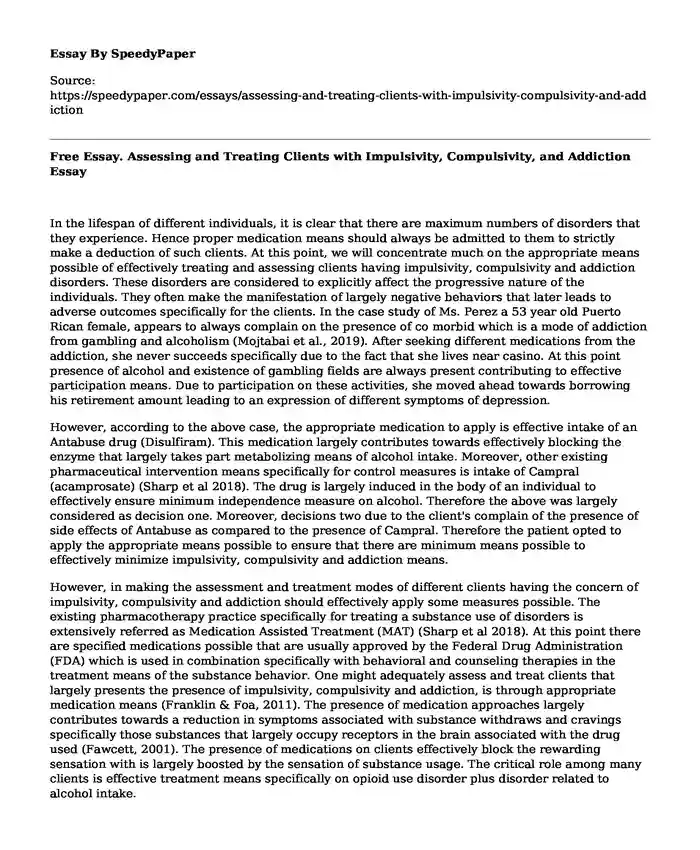
| Type of paper: | Course work |
| Categories: | Public health Substance abuse Psychological disorder Behavior change |
| Pages: | 3 |
| Wordcount: | 793 words |
In the lifespan of different individuals, it is clear that there are maximum numbers of disorders that they experience. Hence proper medication means should always be admitted to them to strictly make a deduction of such clients. At this point, we will concentrate much on the appropriate means possible of effectively treating and assessing clients having impulsivity, compulsivity and addiction disorders. These disorders are considered to explicitly affect the progressive nature of the individuals. They often make the manifestation of largely negative behaviors that later leads to adverse outcomes specifically for the clients. In the case study of Ms. Perez a 53 year old Puerto Rican female, appears to always complain on the presence of co morbid which is a mode of addiction from gambling and alcoholism (Mojtabai et al., 2019). After seeking different medications from the addiction, she never succeeds specifically due to the fact that she lives near casino. At this point presence of alcohol and existence of gambling fields are always present contributing to effective participation means. Due to participation on these activities, she moved ahead towards borrowing his retirement amount leading to an expression of different symptoms of depression.
However, according to the above case, the appropriate medication to apply is effective intake of an Antabuse drug (Disulfiram). This medication largely contributes towards effectively blocking the enzyme that largely takes part metabolizing means of alcohol intake. Moreover, other existing pharmaceutical intervention means specifically for control measures is intake of Campral (acamprosate) (Sharp et al 2018). The drug is largely induced in the body of an individual to effectively ensure minimum independence measure on alcohol. Therefore the above was largely considered as decision one. Moreover, decisions two due to the client's complain of the presence of side effects of Antabuse as compared to the presence of Campral. Therefore the patient opted to apply the appropriate means possible to ensure that there are minimum means possible to effectively minimize impulsivity, compulsivity and addiction means.
However, in making the assessment and treatment modes of different clients having the concern of impulsivity, compulsivity and addiction should effectively apply some measures possible. The existing pharmacotherapy practice specifically for treating a substance use of disorders is extensively referred as Medication Assisted Treatment (MAT) (Sharp et al 2018). At this point there are specified medications possible that are usually approved by the Federal Drug Administration (FDA) which is used in combination specifically with behavioral and counseling therapies in the treatment means of the substance behavior. One might adequately assess and treat clients that largely presents the presence of impulsivity, compulsivity and addiction, is through appropriate medication means (Franklin & Foa, 2011). The presence of medication approaches largely contributes towards a reduction in symptoms associated with substance withdraws and cravings specifically those substances that largely occupy receptors in the brain associated with the drug used (Fawcett, 2001). The presence of medications on clients effectively block the rewarding sensation with is largely boosted by the sensation of substance usage. The critical role among many clients is effective treatment means specifically on opioid use disorder plus disorder related to alcohol intake.
Therefore, in the case of the 53 year-old female from Puerto, an addict of gambling disorder, smoking addiction and usage of alcohol is effective application of the pharmacotherapy approaches. The first approach at this situation is injection means of Naltraxone (Vivitrol), 380gm intramuscularly in the gluteal section every four weeks (Mojtabai et al., 2019). At this point the pharmacotherapy should adequately be applied to the alcohol victims whom are at risk of the alcohol addiction rates. Their purposes are effectively inhibiting the control measures of alcohol in body and motivate the user to focus on life progress (Castel et al., 2006). Hence the appropriate means possible is optimization act of the clients through effective encouragement regular clinical laboratory tests, routine screening techniques, treatment referrals and brief interventions. Moreover the presence of client's confidentiality and autonomy should always be maintained specifically to prescribe medications relating to addiction.
References
Castel, S., Rush, B., Urbanoski, K., & Toneatto, T. (2006). Overlap of clusters of psychiatric symptoms among clients of a comprehensive addiction treatment service. Psychology of Addictive Behaviors, 20(1), 28.
Fawcett, J. (2001). Treating impulsivity and anxiety in the suicidal patient. Annals of the New York Academy of Sciences, 932(1), 94-105.
Franklin, M. E., & Foa, E. B. (2011). Treatment of obsessive compulsive disorder. Annual review of clinical psychology, 7, 229-243.
Mojtabai, R., Mauro, C., Wall, M.M., Barry, C. L., & Olfson, M. (2019). Medication treatment for opioid use disorders in substance use treatment facilities. Health Affairs, 38(1), 14 23. Retrieved from https://www.healthaffairs.org/doi/abs/10.1377/hlthaff.2018.05162
Sharp, A., Jones, A., Sherwood, J., Kutsa, O., Honermann, B., & Millett, G. (2018). Impact of Medicaid expansion on access to opioid analgesic medications and medication-assisted treatment. American journal of public health, 108(5), 642-648. Retrieved from https://ajph.aphapublications.org/doi/abs/10.2105/AJPH.2018.304338
Cite this page
Free Essay. Assessing and Treating Clients with Impulsivity, Compulsivity, and Addiction. (2023, May 22). Retrieved from https://speedypaper.net/essays/assessing-and-treating-clients-with-impulsivity-compulsivity-and-addiction
Request Removal
If you are the original author of this essay and no longer wish to have it published on the SpeedyPaper website, please click below to request its removal:
- Education Essay Sample: Project Based Learning (PBL) for Students with Autism
- Pyramids of Giza
- Paper Sample for Free: Diet and Fitness about Breast Cancer
- Free Essay Example with the Patient Assessment
- Free Essay Sample. Insulin and Diabetes Mellitus
- Essay Sample on Level of Regulatory Authority Scope Role within U.S. Healthcare System
- Witch Hunts and the Beginning of the Sexual Division of Labor in Sylvia Federici's Text - Essay Sample
Popular categories




